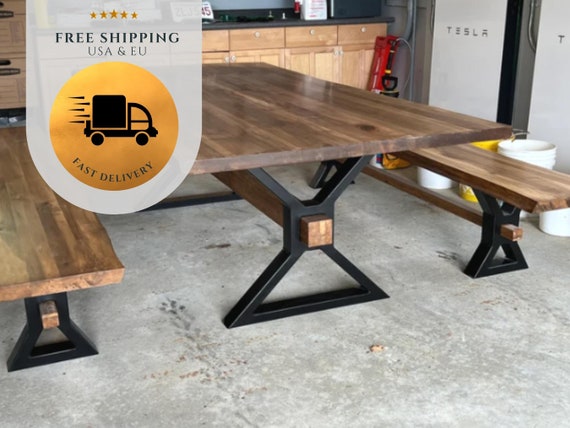Top Patterns in Dining Room Table Legs to Raise Your Dining Area
Top Patterns in Dining Room Table Legs to Raise Your Dining Area
Blog Article
An In-depth Look at Eating Table Leg Styles: Finding the Suitable Suit
Choosing the right table leg design is critical for both visual charm and practical functionality. Standard 4 legs use ageless style and security, while the pedestal base supplies enhanced legroom and a contemporary look. For those with larger tables, trestle legs guarantee durable assistance, whereas hairpin legs introduce a mid-century modern-day vibe with their minimal style. The x-shaped legs blend contemporary style with improved stability. Each of these choices brings special benefits, making the choice a lot more than simply a matter of preference. Explore further to discover which style perfectly matches your dining area and lifestyle.
Typical 4 Legs
Amongst the numerous types of dining table leg designs, the conventional four-leg design remains an ageless choice for many households. Four legs give well balanced support, making certain the table continues to be secure and capable of birthing considerable weight (dining room table legs).
From a visual viewpoint, the standard four-leg layout can be quickly adapted to various interior styles. Whether crafted from wood, steel, or a combination of materials, these legs can be elaborately carved, sleek and minimalistic, or anything in between. Their flexibility permits them to match both rustic and contemporary settings perfectly.
Furthermore, the straightforward structure of the four-leg style promotes convenience of activity and placement within a space. Unlike more complicated bases, this style minimizes obstructions, providing adequate legroom for diners. In summary, the standard four-leg table leg design weds sustaining elegance with useful capability, making it an astute selection for those looking for both kind and function in their eating furniture.
Pedestal Base
Often celebrated for its sophisticated and space-efficient style, the stand base is a recognized option to the typical four-leg setup in eating table leg styles. Without corner legs, restaurants are afforded better flexibility of motion, making it an optimal selection for round and oval tables that advertise even more intimate and comprehensive celebrations.
The main column itself offers a canvas for complex styles and creative expressions, including a component of aesthetic rate of interest beneath the table. In recap, the pedestal base combines performance with style, making it an improved and functional option for varied dining settings.
Trestle Legs
Trestle legs supply a robust and ageless foundation for eating tables, characterized by their straight cross-bracing and durable assistance beam of lights. Stemming from medieval times, this layout has advanced yet kept its essential framework, making it a perennial favorite in both typical and contemporary setups. The central trestle light beam, frequently sustained by 2 or more upright posts, uses remarkable security, allowing for larger table sizes without the need for extra legs.
A substantial advantage of trestle leg tables is the adequate legroom they offer. Unlike tables with four edge legs, the lack of obstructions at the table's edges supplies unimpeded space for chairs and restaurants, boosting comfort and ease of access. This makes trestle tables excellent for accommodating larger celebrations, whether in a dining-room or a banquet hall.
The visual convenience of trestle legs is significant. Available in a range of products such as timber, steel, and composite, they can be finished to complement a variety of indoor styles. From rustic farmhouse to sleek contemporary styles, trestle legs can be personalized to match specific preferences. Their long-lasting appeal and functional benefits make trestle legs a compelling choice for those seeking both style and functionality in their table.
Hairpin Legs

The appeal of hairpin legs depends on their simplicity and flexibility - dining room table legs. Readily available in a variety of materials, consisting of steel and brass, they can be finished in various shades to enhance different interior styles. Whether coupled with a rustic wood tabletop or a contemporary glass surface area, barrette legs easily mix functionality with a touch of view publisher site vintage appeal
Durability is another significant attribute of barrette legs. Regardless of their delicate look, these legs are crafted to birth considerable weight, making sure the table remains steady and safe and secure. In addition, they are fairly easy to mount, making them a prominent selection for DIY lovers and expert furniture makers alike.
X-Shaped Legs
Created from materials such as steel, timber, or a mix of both, X-shaped legs can be tailored to match different layout preferences. Steel legs commonly lend a smooth and commercial feeling, ideal for loft-style apartment or condos and modern dining areas. On the various other hand, wooden X-shaped legs provide a warmer, a lot more rustic appeal, suitable for farmhouse or eclectic insides. The versatility in materials enables home you could try this out owners to customize their table to better fit their general layout system.
Additionally, the design behind X-shaped legs makes certain also weight circulation, minimizing the risk of wobbling and enhancing resilience. This makes them especially appropriate for larger dining tables that need extra support. In essence, X-shaped legs blend useful engineering with modern aesthetic appeals, making them an ageless option for diverse dining environments.
Conclusion
A thorough understanding of table leg designs discloses the distinctive features and benefits of each design. Standard 4 legs use security and timeless allure, while stand bases supply legroom and a streamlined look. Trestle legs ensure durable support for larger tables, and hairpin legs present a mid-century contemporary aesthetic. X-shaped legs integrate modern style with improved security. Picking the ideal leg design ensures both practical and visual contentment in any kind of dining area.
Report this page